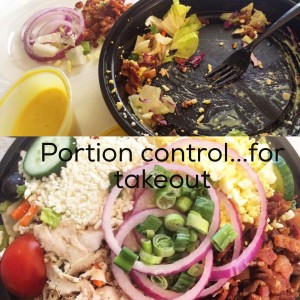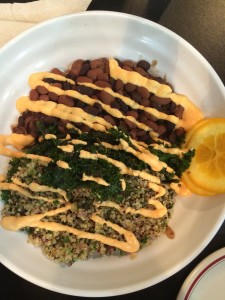 If eating at restaurants and/or parties is a regular part of your life (as in, it happens more than 2-3 times a month), keep reading.
If eating at restaurants and/or parties is a regular part of your life (as in, it happens more than 2-3 times a month), keep reading.
I recently started eating at restaurants for as many as 5 meals a week – life has its seasons – so this is my real, here’s-what-I’m-doing-as-a-personal-trainer advice for how to eat healthy when you aren’t the one preparing the food. I think eating in restaurants can be a great way to enjoy your meals if you stick to these guidelines!
1. Get your head in the game.
If you’re eating out at restaurants often (more than 2-3 times a month), accept that these meals are no longer a “treat” or a “splurge” or a “special occasion that requires me to throw caution to the wind”. Yes, caution-free meals do exist…but you probably won’t reach your health and fitness goals if you put every meal on that list.
So, let’s swap the idea of free-for-all funtime for the notion of nourishment: we are going to choose what’s best for us and our goals, and it’s not going to be a sad pile of flavorless goo or a stack of pale iceberg misery.
2. Make your own choices.
Your friend wants truffle fries but they’re not what you think is best for you tonight? You don’t have to agree to share some so that s/he doesn’t feel guilty for ordering a basket. Same goes for apps ordered for the “table” – if there’s something that you really want, have at it..but otherwise, try not to pick at something just because it’s in front of you.
“Oh, you married Jason?!” “Well, he was here in front of me….”
See? That’s not how we make choices about what’s best for us.
3. Focus on quality.
Higher quality ingredients – those that are less processed than their frankenfood counterparts – are less inflammatory (one of many basic sources), so whatever it is that you’re going to eat, choose the highest quality version of it that you can eat. When I eat a cheeseburger, the beef is grass-fed, organic, and freshly ground, and it comes wrapped in lettuce. If I eat ice cream, it’s locally made from organic milk and natural sweeteners.
 4. Find balance.
4. Find balance.
Think in terms of macronutrients – carbs, protein, and fats – when you choose your meal. Not sure what I mean? The basics, as far as it goes for eating in restaurants:
Protein: Meat, fish, eggs, tofu
Fat: dressings and sauces, avocado, cheese
Carbs: everything else! bread, rice, pasta, potatoes, tortilla chips….
If you’re my client, you know what your balance of macronutrients should look like; if you’re not, 40% carbs, 30% protein, and 30% fat is a common guideline that may or may not be right for you. Whatever your balance, either:
- choose a dish that comes pre-balanced (e.g. a salad topped with grilled chicken, dressing on the side for portion control) OR
- arrange your dish to match your macros once it arrives
For example, a restaurant serving of pasta with grilled chicken and sauce probably comes with one adequate serving of chicken and three servings of pasta. So, commit to boxing up 2/3 of your pasta to eat at future meals.
Another example: pizza (what?!). One restaurant sized piece typically has enough crust and cheese for an entire meal’s carbs and fat, but no matter how many meat and veggie toppings you add it doesn’t have enough protein and fat. Consider balancing it out with a side salad topped with grilled chicken, or another combo of protein and veggies.
Balance everything you’re eating in your meal. The appetizer and dessert aren’t “bonuses” – they’re part of what you’re eating if you order them. Your dessert can easily use up your meal’s carb allotment (as can unfettered chip and salsa consumption), so find a balance between what you want and what’s best for you.
5. Speaking of portion sizes…
The palm of your hand is about 3-4oz of protein.
Your fist is about 1 cup of pasta or rice (which can be two servings, depending on your macronutrient needs.)
Your full thumb is about 1 tablespoon (useful for salad dressings).
Your two lightly cupped hands are about one serving of chips.
It’s not news that restaurant portions can vary like CRAZY, so eyeball your portion sizes while you’re balancing your macronutrients.
6. Enjoy the experience.
Slow down, relax with your dining company, soak in the flavors, and savor the moment. Even if you eat in restaurants daily (…or, if you’re eating at home, for that matter), eating slowly and enjoying your meal allows you to digest your food more fully and easily.
7. Budget your alcohol.
Alcohol is full of inflammatory empty calories. BUT, y’all are going to drink it anyway. So, set a budget and stick to it. (For health, the US government recommends no more than 7 drinks per week for women…per week…and those are 5 oz pours of wine. Just saying.)
And don’t waste your calories on soda (or sweet tea, or any other high fructose corn syrup-sweetened beverage). Seriously. It’s 2016 and we all know better, right? Those are carbs that you could be eating in the form of cake!
8. MyFitnessPal has lots of restaurant items in its database…
…and if your specific meal isn’t in there, you can still track pretty well by making sure you enter at least the main source of protein, of carbs, and of fat from each plate that you consume. Tracking doesn’t (usually) have to be 100% perfect to be worth your while – 90% perfect is pretty good for a restaurant meal.
These guidelines should help you get out of your home cooking rut and enjoy some social time without throwing all your health and fitness progress down the drain. It’s unrealistic to think that you will never go out to eat again, and it’s dismal to eat only grilled chicken and unseasoned vegetables at every single meal. There are so many fabulous cuisines in the world, and if you watch your portion sizes and at least eyeball your macronutrients, restaurant meals can be a sustainable part of lifelong health!

